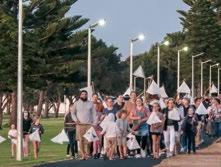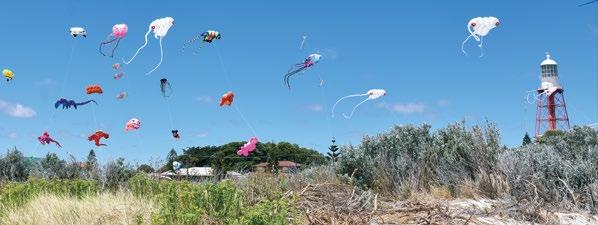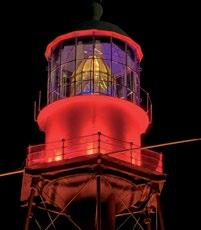
3 minute read
SHINE ON KINGSTON
PICTURED:

Advertisement
The illuminated Cape Jaffa Lighthouse at Kingston was a stunning visual beacon. Bottom right: The magnificent Chance Brothers prism lens shone like a jewel.
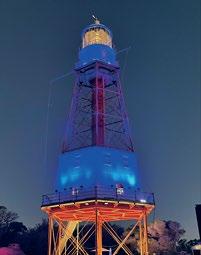
shine on kingston! A brilliant success
ALISON STILLWELL OAM, NTSA COUNCILLOR
kingston really did shine in January when the Limestone Coast town celebrated the 150th anniversary of the National Trust’s iconic Cape Jaffa Lighthouse.
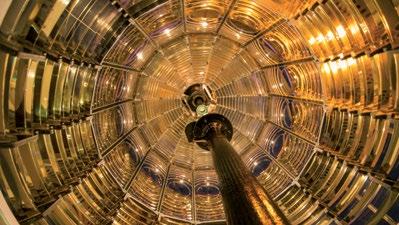
From an exhibition of logbook pages dating back to 1872 to a memorable interview with the last lightkeeper and launching the LIGHTHOUSE Art Prize, Shine On Kingston! delivered a feeling of joy in the midst of a pandemic. The pièce de résistance and climax of the celebrations was stunning illumination of the lighthouse by Adelaide sound and lighting company, Osmond Electronics. Lights of several types were placed in and around the skeletal structure, giving it a commanding presence and drawing out elements normally overlooked. The magnificent First Order dioptric revolving lens used to exhibit light for the first time on January 15 1872, shone out like a jewel atop the structure which was bathed in bold, changing colours. People spread out on the foreshore lawns and watched from their homes or any vantage point they could find. Strong community involvement ensured a comprehensive and diverse approach to celebrating the lighthouse’s anniversary. Musical highlights included sea shanties and other maritimerelated songs courtesy of the Kingston Community Choir and the Mosquito Plains Strummers (ukuleles); and a performance by noted country singer Graeme Hugo. Kingston Community School students created a lantern parade, the Lacepede Bay Sailing Club staged a regatta, Adelaide Kite Flyers flew kites during the day and illuminated at night, and Mt Benson vignerons poured wine to drink with locally-made crayfish pate. Keynote presentations on fascinating topics intimately connected with the lighthouse and its history kept audiences glued to their seats throughout the day. Speakers covered the work of the Lighthouses of Australia organisation, the illumination process in lighthouses with First Order lenses, the experiences of a lightkeeper on the Cape Jaffa Light Station, how the lighthouse platform was saved from demolition, the bravery of lightkeepers in rescuing victims of a shipwreck, and modern-day rescues in dangerous marine environments. There was also a display of marine rescue vehicles. One of five exhibitions staged in the District Hall helped people imagine the lives led by lightkeepers and their families. Photographs taken at sea level and by drones impressed visitors with clear depictions of the light station’s isolated location on Margaret Brock Reef, and ruins of the lightkeepers’ cottages on a wind-swept point south of Cape Jaffa. Another exhibition showcased 25 images from the 1802 expedition to map the coastline, led by French explorer Nicolas Baudin; and a touring banner exhibition from the Australian National Maritime Museum – Remarkable – focused on remarkable stories of Australians and their boats. Another display featured knitted artwork depicting global warming data – The Tempestry Project. Local knitters selected a specific year and knitted rows in specified colours to represent a certain range of maximum daily temperatures. Ten knitters produced 17 ‘banners’, each the width of a scarf. Memorable lighthouse moments in the selected years linked this project firmly to the Cape Jaffa Lighthouse story. Every facet of the story continues to amaze both visitors and guides alike, from construction of the lighthouse in the early 1870s after 48 shipwrecks in area, to its relocation after 101 years of operation when it became the first offshore lighthouse in Australia to be dismantled and rebuilt onshore. Its future was secured when the Federal Minister for Transport, the Hon. C. K. Jones, agreed to give the structure to the National Trust. The official hand over was made on 24 January 1976. Regrettably, there are many people who are unable to access the lighthouse and would love to learn about its history, however the National Trust plans to remedy this situation. An interpretive centre is planned for the lighthouse grounds to provide a more accessible and extensive visitor experience. The new facility will include a replica of the galley which originally stood adjacent to the tower to provide a flexible space for displays and community meetings; and interpretive trails featuring First Nations stories associated with the coastline and hinterland.
Left: Children’s lantern parade. Below: Kites on the foreshore.
